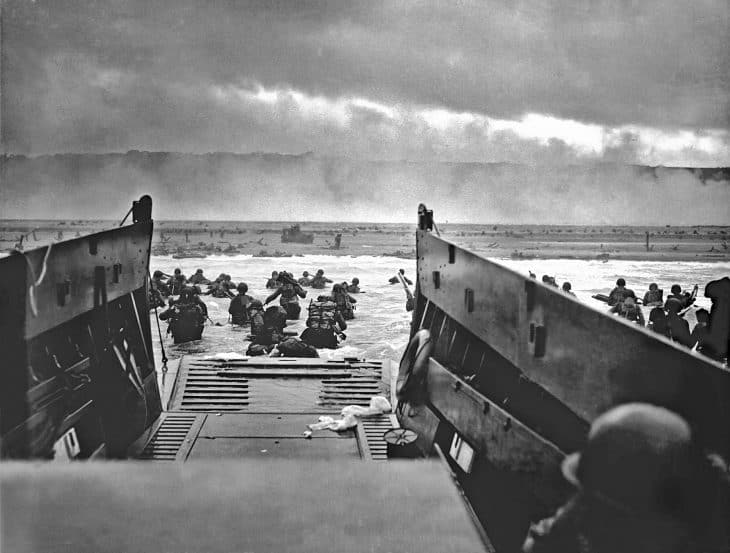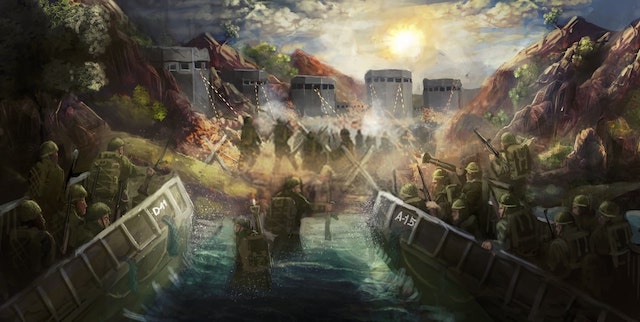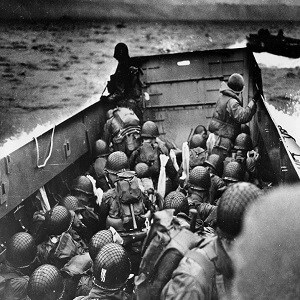
- 01Definition: The day of invasion
- 02Date: June 6, 1944
- 03Invaders: The Allies
- 04Location: Normandy, France
- 05War: World War II
- 06Casualties: 10,000 – 15,000 on both sides
- 07Operation: Neptune
- 08Result: Allied victory, liberation of Western Europe
- 09Leader: General Dwight D. Eisenhower
- 10Movies: Saving Private Ryan, The Longest Day, Eye of the Needle
- 01Definition: D-Day Is a Military Term for the Beginning of an Attack or Operation
- 02Purpose: D-Day Was Part of an Operation That Aimed to Liberate Nazi-Occupied Europe
- 03Effect: The D-Day Invasion Might Have Won the War for the Allies
- 04Scope: D-Day Started the Largest Seaborne Invasion in the History of Mankind
- 05Planning: Operation Bodyguard Was a Deception Designed to Enable D-Day Landings
- 06Allies: Troops from Many Countries Participated in the D-Day Landings
- 07Location: The Landing Site on the Coast of Normandy Was Divided into 5 Sectors
- 08Time: D-Day Was Initially Scheduled for June 5, 1944
- 09Tactics: The D-Day Beach Landings Were Accompanied by Bombings and Airborne Landings
- 10Result: The D-Day Operations Didn’t Succeed in Full
- 01D-Day Is Considered to Be the Start of the Cold War by Some Historians
- 02Surprise Was Crucial for the Success of the Day-D Invasion
- 03Erwin Rommel Was Celebrating His Wife’s Birthday When the Attack Came
- 04The First Allied Soldier Killed on D-Day Was British
- 05Winston Churchill Almost Took Part in the Invasion
- 06Fewer Than 50% of Troops That Landed in Normandy on D-Day Were American
- 07Allied Soldiers Were on Average 5 Years Younger than the Germans
- 08Theodore Roosevelt’s Eldest Son Was among the Allied Soldiers on D-Day
- 09D-Day Has Various Names across the World
- 10The Author of The Catcher in the Rye Was among US D-Day Troops
D-Day Is a Military Term for the Beginning of an Attack or Operation

D-Day facts reveal that the most famous D-Day (and the one most people think of when they hear the term) occurred in 1944 when the Allied forces landed on the shores of Normandy. In a broader sense, however, D-Day can be a name for the beginning of any military attack or operation.
The “D” in the term D-Day is most commonly interpreted as meaning a day itself, giving the term the meaning of “the day day” or “the day of days”. The term was used in World War I, too, and has been used many times since – both prior to and after World War II.
D-Day Was Part of an Operation That Aimed to Liberate Nazi-Occupied Europe
As D-Day facts show, Operation Overlord was the codename for the Battle of Normandy, the battle whose intention was to invade Nazi-occupied Western Europe and liberate it from Nazi oppression.
D-Day, also known as Operation Neptune after the Roman god of the sea, was just the beginning (the first day) of Operation Overlord, which lasted for an additional three months, until the end of August 1944, and re-opened the western front of battle in Europe for the first time since 1940 and the Battle of Britain.
The D-Day Invasion Might Have Won the War for the Allies
Although World War II effectively ended almost a year later, D-Day facts reveal that this surprise invasion of Normandy might have been the key for final victory over the Nazis and their allies in Europe.
Because of D-Day, Hitler was forced to open a second front in Europe, driving his forces out of the Eastern Front and allowing the Soviets to press the German army from the east – an advance that ended about a year later, in April and May 1945, with the Soviet army capturing the part of Germany that later became known as the German Democratic Republic, or East Germany.
D-Day Started the Largest Seaborne Invasion in the History of Mankind
During D-Day, June 6, 1944, about 150,000 Allied soldiers faced about 50,000 German soldiers on the coast of Normandy after being deployed there by airplanes and amphibious military vehicles. But that was just the beginning – more than 80 days of combat followed under Operation Overlord, during which over 1,000,000 troops fought for the Allies and around 400,000 for the Germans.
Some 5,000 landing and assault crafts, nearly 300 escort vessels and nearly 300 minesweepers make the D-Day landings the biggest seaborne invasion in history. It started at about 6.30 am (with airborne units being deployed a few hours before, just after midnight) and lasted throughout the day.
Operation Bodyguard Was a Deception Designed to Enable D-Day Landings
D-Day facts reveal that D-Day landings and Operation Overlord that followed might not have been executed if not for the deception that was named Operation Bodyguard. Operation Bodyguard was a fictional operation designed to mislead the German command about the real time and place of the invasion of Europe.
Several sub-operations under the common name Operation Bodyguard, including Operation Zeppelin, Operation Fortitude and Operation Graffham, were carried out in 1944 to confuse the Germans – and they succeeded, making the D-Day landings in June 1944 a complete surprise for the enemy.
Troops from Many Countries Participated in the D-Day Landings

Allied forces that invaded the shore of Normandy in the early morning of June 6, 1944 consisted mostly of American, Canadian and British troops, and were supported by Australian, Belgian, Danish, French, Czechoslovakian, Greek, Dutch, Norwegian, Polish and New Zealand troops, all under the joint command of General Dwight D. Eisenhower.
German troops that were opposing them were led by Field Marshals Gerd von Rundstedt and Erwin Rommel. The latter, known also as the Desert Fox (a nickname earned for his success in the North African Campaign during World War II), was severely injured in the period of combat that followed through June and July.
The Landing Site on the Coast of Normandy Was Divided into 5 Sectors

D-Day facts show that these five target sectors of the Normandy coastline were Utah Beach, Omaha Beach, Juno Beach, Gold Beach and Sword Beach. Of them, Omaha Beach was the area with the strongest German defence, and the 1st Infantry Division and the 29th Infantry Division of the US Army suffered heavy losses there.
Approximately 2,000 Allied soldiers died on Omaha Beach that day as they were victims of German fire from the cliffs above the beach. The objectives that were set for the Omaha Beach attack prior to the operation were achieved only three days later.
D-Day Was Initially Scheduled for June 5, 1944
Months of planning were invested in the beginning of the Normandy invasion and multiple factors influenced the planning; among them, the weather. The planners of the invasion wished to attack at full moon in order to have the highest possible tide and the invasion was initially scheduled one day earlier than it actually happened, on June 5, 1944.
Bad weather was the reason why the landing got postponed, since high winds and low clouds made invasion from both the sea and air difficult. Another possibility was to postpone the invasion until June 18-20, but luckily Eisenhower and his advisers decided to proceed on June 6 – two weeks later, a huge storm hit Normandy and the beach landings would have been impossible at that time…
The D-Day Beach Landings Were Accompanied by Bombings and Airborne Landings
Although D-Day mostly refers to the naval operation that used vessels to land the troops on the coast of Normandy, it was heavily supported by other forms of warfare, namely prior bombings of the area and airborne landings of key strategic locations.
The bombing started at midnight and lasted until the landings began at 6.30 am in most areas. Airborne landings started a few minutes after midnight – the main objective was to capture, or in some cases destroy, important strategic locations such as bridges.
The D-Day Operations Didn’t Succeed in Full
Most of the D-Day invasion was a great success, but Allied forces didn’t accomplish all of their objectives. Among the biggest failures was the inability of the Allied troops to capture the city of Caen (which was eventually captured at the end of July, a month and a half after D-Day) and the failure to connect all five landing sites (beaches). The cities of Carentan, St. Lô and Bayeux were also intended to be captured on the first day, but remained in German hands.
D-Day Is Considered to Be the Start of the Cold War by Some Historians
Although D-Day was a great success, weakening the Nazi occupation of Europe, some historians also believe that it was the start of the Cold War – the war of tension (without major fighting) that lasted for almost 50 years after World War II ended and shaped the world into what it is today.
And how could the D-Day invasion have started the Cold War? It forced the Nazis to focus on the west of Europe, giving the Soviet Union an opportunity to push and liberate Europe from the eastern side. This race for Europe, from the west for western Allies and from the east from the Soviets, was the start of the tensions that later arose between the Western Bloc, represented by the USA and its NATO allies, and the Eastern Bloc, represented by the Soviet Union and its Warsaw Pact allies.
Surprise Was Crucial for the Success of the Day-D Invasion
In any combat, a surprise can add an additional edge, but surprise was absolutely crucial for the success of the landings in Normandy in June 1944. Why? Because the Allies could only transport 8 divisions on the morning of the landings and the Germans had a total of 55 divisions in France at the time…
To create this much-needed surprise, the Allies were forced to spend months and countless resources on deceptive operations that would mislead the Germans, but they succeeded in the end.
Erwin Rommel Was Celebrating His Wife’s Birthday When the Attack Came
The Germans expected an attack by the Allies, but weren’t sure when and where it would happen. The bad weather in Normandy during June 1944 gave them a false sense of safety, and Erwin Rommel, one of the leading German Officers in the combat that followed D-Day, was so convinced of their safety that he visited Germany to give his wife a pair of shoes for her birthday. He was still in Germany when he got the news that the Allied forces had invaded.
The First Allied Soldier Killed on D-Day Was British
D-Day facts reveal that his name was Lieutenant Herbert Denham Brotheridge (also known as Den Brotheridge) and he served in the Oxfordshire and Buckinghamshire Light Infantry regiment. His unit was the first to land in Normandy and he died of wounds in the early hours of the morning at the age of 28. His daughter Margaret was born 2 weeks after he was killed in action. He is buried in the war cemetery near Caen, in Ranville village – the first French village to be liberated in 1944.
Winston Churchill Almost Took Part in the Invasion
Churchill wanted to support the troops, so he devised a plan of joining the fleet and watching the landings from the HMS Belfast. But his presence on the ship was perceived as far too dangerous by many, so they advised against it, but the great man just wouldn’t give in.
In the end, it took King George VI’s “threat” to join him on the ship to finally convince Churchill to change his mind. Great Britain just couldn’t afford to potentially lose two of their most important leaders at the same time…
Fewer Than 50% of Troops That Landed in Normandy on D-Day Were American
Although the USA had overall command of the operation through General Eisenhower, fewer than 50% of soldiers landing on the shores that day were American. Out of about 156,000 men, 73,000 were American, the rest mostly British and Canadian.
D-Day facts also show that British soldiers were severely underpaid in comparison to the Americans – their infantry men, for example, were paid less than £4 for a month of military service during the war, while the Americans got three times more for the same period: £12.
Allied Soldiers Were on Average 5 Years Younger than the Germans
Experience counts for a lot when talking about military confrontations, but the Allied forces managed to win despite the fact that the German forces were more experienced and on average five years older.
And why were the German soldiers fighting in the D-Day invasion so much older in the first place? Because they had had major casualties on the Eastern Front in the previous years and thus had fewer and fewer young men to enlist to the army, needing to rely only on seasoned men.
Theodore Roosevelt’s Eldest Son Was among the Allied Soldiers on D-Day
In fact, D-Day facts reveal that he was the oldest soldier to storm the beaches of Normandy on that day at 56 years of age. Theodore Roosevelt, Jr. (also known as Theodore Roosevelt III) was initially not allowed to participate, but managed to get himself accepted after a written request.
After the landing, he stormed Utah Beach with the first wave of troops. He survived the initial attack, but died of a heart attack 36 days later, still in Normandy. His son Quentin Roosevelt II, the great president’s grandson, was also among the troops that landed in Normandy on D-Day; he survived the war, but died shortly after, in a plane crash in 1948.
D-Day Has Various Names across the World
For the majority of the world’s English speaking population, the start of the invasion of Normandy might be known as D-Day, but speakers of other languages know it by other names. For example, in Indonesia it is known as “Hari H”, in France as “Jour J”, in Romania as “Ziua Z”, in Basque as “E eguna” and in Germany as “Tag X”.
To add to the confusion, you should also know that A-Day and L-Day were two completely different battles, occurring later in World War II…
The Author of The Catcher in the Rye Was among US D-Day Troops
J.D. Salinger landed on Utah Beach with the second wave, a few minutes after 6.30 am. He was an officer in the 4th Counter Intelligence Corps and allegedly had the first few chapters of what later became an American classic in his backpack.
In the campaign that followed the D-Day landings, Salinger arranged to meet the great novelist Ernest Hemingway who worked as a correspondent in Paris at the time. The two men met and were supposedly impressed by each other, so they started corresponding. Salinger’s masterpiece The Catcher in the Rye was published six years after the war had ended.
D-Day Facts — Facts about D Day Invasion
 Although D-Day is a general military term used to denote the start of combat or an operation, it is most often used to refer to the landings of the Allied forces in Normandy during World War II on June 6, 1944. D-Day landings were only the beginning of a bigger operation – Operation Overlord, which aimed at liberating Nazi-occupied Western Europe. It was planned in utmost secrecy with the help of several fake operations that were designed to confuse the Germans, since it needed to be a complete surprise in order to have a chance of success. Despite many thousands of deaths on both sides, the naval operation, which was supported by bombing and airborne troops, succeeded, having a great impact on the rest of the war since it forced Germany to open a second front in Europe.
Although D-Day is a general military term used to denote the start of combat or an operation, it is most often used to refer to the landings of the Allied forces in Normandy during World War II on June 6, 1944. D-Day landings were only the beginning of a bigger operation – Operation Overlord, which aimed at liberating Nazi-occupied Western Europe. It was planned in utmost secrecy with the help of several fake operations that were designed to confuse the Germans, since it needed to be a complete surprise in order to have a chance of success. Despite many thousands of deaths on both sides, the naval operation, which was supported by bombing and airborne troops, succeeded, having a great impact on the rest of the war since it forced Germany to open a second front in Europe.
Was this page helpful?
Our commitment to delivering trustworthy and engaging content is at the heart of what we do. Each fact on our site is contributed by real users like you, bringing a wealth of diverse insights and information. To ensure the highest standards of accuracy and reliability, our dedicated editors meticulously review each submission. This process guarantees that the facts we share are not only fascinating but also credible. Trust in our commitment to quality and authenticity as you explore and learn with us.


